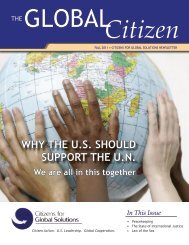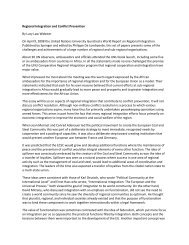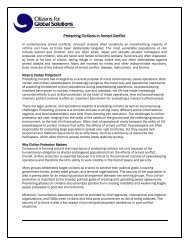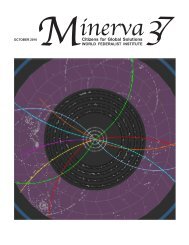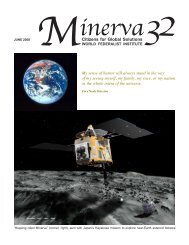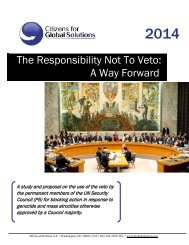Minerva, Fall 2011 - Citizens for Global Solutions
Minerva, Fall 2011 - Citizens for Global Solutions
Minerva, Fall 2011 - Citizens for Global Solutions
- No tags were found...
You also want an ePaper? Increase the reach of your titles
YUMPU automatically turns print PDFs into web optimized ePapers that Google loves.
caucus statement representing the will ofthe world’s indigenous peoples. Usually,this statement summarizes the consensusand prioritizes specific positions <strong>for</strong> theEMRIP members to include in the finalreport. The pre-session still serves theimportant task of updating one anotheron urgent matters and focusing on the upcomingsession.A new feature at the 4th session was anexpert consultation focusing on NationalHuman Rights Institutions (NHRIs) andthe realization of the UN Declaration onthe Rights of Indigenous Peoples (UNDRIP). Representatives of NHRIs fromKenya, Canada, Philippines, El Salvador,Namibia, New Zealand, Panama,South Africa, Russian Federation, Peru,Australia and Malaysia shared their bestpractices and also held discussions on theoperationalization of the UN DRIP. Animportant result from the consultation wasthe sharing of an outline of an operationalguide being drafted by the Australian HumanRights Commission and Asia-PacificForum. This guide provides backgroundand the legal basis <strong>for</strong> the UN DRIP andpractical guidance <strong>for</strong> NHRIs and statesthrough case studies. On top of the expertconsultation, the NHRIs also played asignificant participatory role throughoutthe 4th session.At the opening plenary, Rosslyn Noonan,Chief Commissioner of the New ZealandHuman Rights Commission and Chairpersonof the International CoordinatingCommittee of National Human RightsInstitutions, addressed the aspirations ofthe developing partnership to improve thehuman rights of indigenous peoples intheir homelands. “National human rightsinstitutions are among the key actors thatcan help promote the work of the ExpertMechanism in country,” Noonan said.“They are domestic actors that work tobridge the gap between the internationalsystem and national realities.”Noonan also noted the importance of theprimary purpose of producing studies byEMRIP in their work to implement indigenousrights, claiming: “The studies youproduce serve as important guidance <strong>for</strong>national actors as they work to translatethe aspirations of the Declaration into tangibleand meaningful processes, policiesand outcomes.”High Commissioner <strong>for</strong> Human RightsNavanethem Pillay spoke <strong>for</strong> the firsttime since the UN DRIP gained acceptanceby all states, and she noted itssignificant purpose <strong>for</strong> partnerships onthe planet: “A milestone of indigenouspeoples’ advocacy is the UN Declarationon the Rights of Indigenous Peoples,which provides a common roadmap andframework <strong>for</strong> action at both the nationaland international level. Its value is nowglobally recognized.” She noted the workahead <strong>for</strong> the world: “The Declarationsets out a blueprint <strong>for</strong> future partnerships23 • <strong>Minerva</strong> #39 • November <strong>2011</strong>between indigenous peoples, States, andother stakeholders, including the privatesector.”Pillay spoke on the topic of participationin decision-making and promoting dignityof indigenous peoples. She sharedher experience on missions monitoringthe human rights situation, noting that indigenouspeoples “continue to suffer theconsequences of colonization and century-long-dispossession.To confront andput an end to such exclusion and inequality,indigenous people must be includedin decision-making.”A significant contribution was the meetingbetween HCHR Pillay and the IndigenousPeoples Caucus during the 4th session.Pillay’s positions and perspective on theimplementation challenges were positive.The candid conversation allowed <strong>for</strong> anexchange of common concerns and commitmentto upcoming global gatheringsrelating to racism and the environment(Rio+20). There was also concern aboutspecial protocols and conventions such asthe Convention on Biological Diversityand the World Intellectual Property Organization,relating to lack of participationin decision-making, as well about incorporationof the rights of the UN DRIP inthe process and instrumentation of internationallaw.The UN Special Rapporteur on the Rightsof Indigenous Peoples, James Anaya,continued to develop a productive, participatoryrole with the UN EMRIP andindigenous peoples in attendance. Representativesof indigenous peoples could requestmeetings in regard to matters withinAnaya’s mandate, including violations ofhuman rights. Anaya was available <strong>for</strong>four of the five session days, receivingwritten reports from the seven regionsproviding substantive insight as to thestatus of indigenous peoples. Anaya alsomet with representatives of North Americaabout an upcoming visit to the UnitedStates to focus on implementation of theUN DRIP, following adoption on 16 December2010.The foundation of EMRIP’s agenda <strong>for</strong>matis review of best practices and casesin thematic studies that have already been



